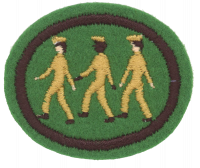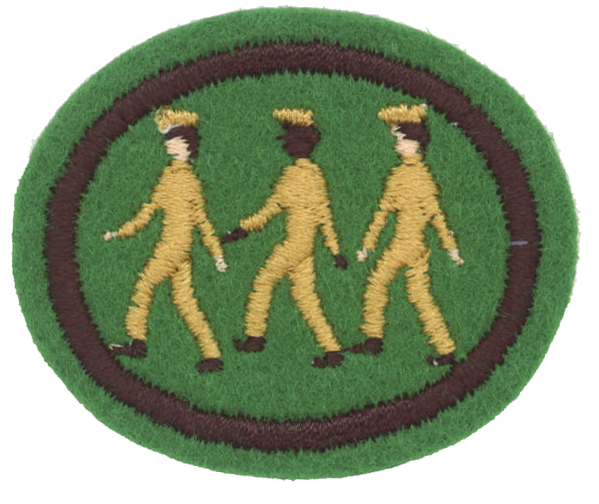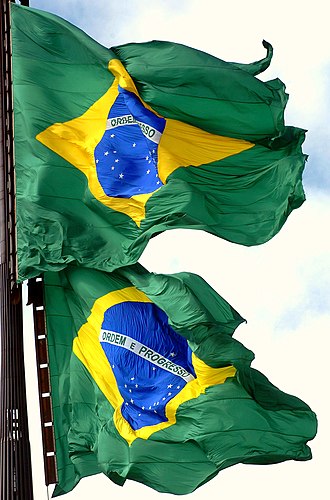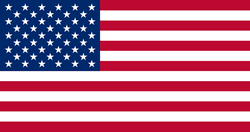AY Honors/Drilling & Marching/Answer Key
1
- Order: It helps maintain an organized unit.
- Morale: Training discipline and group unity.
- Enjoyment: Fun activity, promotes use of imagination.
- Fellowship: Helps one learn to take orders, and follow them.
- Leadership: Helps one learn to give orders and build confidence.
- Self Control: Pay attention to leader.
- Respect: Regard for the rights of others.
2
2a
Formation is the arrangement of the elements of a Pathfinder drill formation in any
prescribed manner.
2b
Line is a formation in which the elements are side by side or abreast of each other. In a
club line the Pathfinders in each unit are abreast of each other with the units one behind the
other.
2c
A rank is a line that is only one element in depth.
2d
An interval is the distance between persons standing next to each other.
2e
A column is formed when people stand one behind one another.
2f
A file is a single column.
2g
Distance is the space between people within a column (front to back).
2h
The cover command is used to align yourself with the person in front of you while maintaining correct distance. Maintaining distance could be exhibited by the raising of left arm at a level or 90 degree angle not at shoulder level to the person to the front.
2i
Flank is the right or left side of any formation from the point of view of someone within that formation.
2j
Cadence is the uniform rhythm in which a movement is executed, or the number of steps
or counts per minute at which the movement is executed.
3
3a
- Parade, REST is the most "strict" of these three commands. It may be called only from the position of Attention. On preparatory commands, the position of Parade REST should be assumed when at STAND AT EASE, AT EASE, or REST. Pathfinders execute Parade REST by moving the left leg out (so feet are about 8 inches apart) and placing both hands in the small of the back, with the right hand on top of the left and thumbs locked together. The head and eyes are to be kept looking straight ahead, because Parade REST is simply a more relaxed form of Attention. STAND AT EASE, AT EASE, or REST and the directive for PRAYER ATTENTION may all be given from this position.
- STAND AT EASE is slightly more relaxed than Parade REST. To do this command, execute parade rest as described above; however, the head and eyes are to follow the commander at all times. Some clubs may allow the hands to relax during STAND AT EASE, but this is not permissible according to the NAD Drill Manual. AT EASE and REST may be commanded from this position.
- AT EASE is more relaxed yet. The right foot must stay "glued" in its place to the ground. Pathfinders are allowed to move around (except for the right foot!), but you must remain silent and standing. REST may be commanded from this position.
- An additional command, REST, is an even more relaxed command. The right foot must still remain "glued" to the ground, and pathfinders must remain standing; however talking is permitted at this position. AT EASE may be commanded from this position.
3b
- Mark time is a command meaning to march in place. When a unit is in Mark time, they should adjust and maintain their intervals and distances. To be proper, it should only be called from Quick time or Half step (Not Double time or from the Halt). However, many clubs find it helpful to use this command from attention for the purpose of instruction. MARK TIME, MARCH can be called as either foot strikes the ground. When the command is given, take one more step after the command of execution (MARCH), plant the trailing foot alongside your stationary foot and march in place. Each foot should be alternately raised approximately 2 inches off the ground at the pace of Quick time. Allow your arms to swing naturally and adjust your alignment as necessary.
- Quick time is marching to the cadence of 120 counts or steps per minute with appx. a 24-inch step. Your arms should swing naturally 9 inches straight to the front and 6 inches to the rear of the seams on your pants. The arms should not bend at the elbow and your fingers should be curled as in the position of attention. Head and eyes should be fixed to the front. Younger Pathfinders may find this hard to achieve at first, but with the help of an instructor, they should be able to master this very quickly.
- Double time is the cadence of 180 counts or steps per minute. The length of the steps is also to be appx. 24 inches. The command DOUBLE TIME, MARCH is given either from a halt or as either foot strikes the ground while marching at Quick time. When given from the halt, at the command MARCH, raise your forearms up to a horizontal position with your fingers and thumb closed, knuckles out, and step off with your left foot. Continue to march at the 180 steps per minute cadence until further instructed. When marching at Quick time, at the command MARCH, take one more step at Quick time and step off with your trailing foot at Double time in the same manner as previously instructed. The only movements that can be executed at Double time are Halt, Quick time, Column Right/Left, and Column Half Right/Left.
3c
- Present, ARMS is mostly used to salute the flag and is a one-count movement given only at the position of attention. To execute this command, raise the right arm and bend at the elbow. The fingers of the right hand should touch the eyebrow, or if glasses are being worn the rim of the glasses, or if a cap or hat is being worn, the brim of the hat (if both glasses and a cap are worn, touch the brim of the cap). The upper arm should be parallel to the ground, and the forearm, wrist, and right hand/fingers should form a straight line (i.e. no bending at joints). The elbow should be swung back so that it does not stick out in front of the body, but not so far that it is behind the body. To Order, ARMS (a one-count movement), simply lower the right arm smartly to your side and resume the position of Attention. There should be no slapping sounds when executing this command.
- Hand Salute is exactly like Present, ARMS but without a command. When reporting or when rendering courtesy, turn the head and eyes toward the person addressed as you salute. Upon acknowledgment, terminate the salute like Order, ARMS, but without a command.
3d
- RIGHT/LEFT FLANK, MARCH - Both the preparatory command(RIGHT/LEFT FLANK) and the command of execution (MARCH) are both given as the foot in the indicated direction strikes the ground (i.e. Left foot for Left Flank). The interval between the preparatory command and the command of execution is one step. At the command MARCH, each Pathfinder takes one more step, turns in the indicated direction on the ball of his leading foot, and steps off in the new direction with his trailing foot. Once marching in the new direction, glance out of the corner of your eye and dress to the right.
- COLUMN RIGHT/LEFT, MARCH - COLUMN RIGHT/LEFT, MARCH can be given from the halt or while marching. From the Halt, the command COLUMN RIGHT/LEFT, MARCH is given and the lead Pathfinder in the column nearest the direction given executes a 90 degree turn in the indicated direction and steps off with their left foot in the new direction taking one 24 inch step then continue at a Half step (12 inches) until the other columns catch up. The lead Pathfinders in the other columns execute a 45 degree turn in the given direction and step off with their left foot in the new direction taking 24 inch steps and continue in an arc. As they come abreast of the other leaders they take up the Half Step. When all leaders are abreast, they step off with a 24 inch step without command. All other club members march forward on the command of execution and execute the column movement at approximately the same location as their unit leaders and in the same manner. While marching, both the preparatory command(COLUMN RIGHT/LEFT) and the command of execution (MARCH) are both given as the foot in the indicated direction strikes the ground (i.e. Left foot for Column Left). The interval between the preparatory command and the command of execution is one step. The execution of the command from here is the same as described above.
4
4a
Standing at attention requires your feet to be together with the your toes at a 45 degree angle. Your hands should be at your sides and curled as if you were holding a coin roll with the thumb over the first knuckle of your index finger. Your eyes should be always facing forward. You are not allowed to talk unless directed to do so. Most stationary commands, as well as the commands used to move a group forward, are called from this position.
4b
Like ATTENTION, your eyes should always be facing forward. When called to PARADE REST, your left foot moves away from your right foot and is set back down when your feet are about a shoulder width apart. Your hands are now behind you at the small of your back with the left hand behind the right hand. The command PARADE REST may only be given from ATTENTION.
4c
STAND AT EASE is exactly like PARADE REST except for two things. The first is that each person's eyes and head should follow the person instructing/addressing the group until the instructor has moved beyond a marcher's shoulder at which point the marcher's head should revert to looking forward until they can see the instructor again. The second is that a marcher's hands may be lower than that of PARADE REST, though the hands must still be in the same order (right hand behind the left hand). STAND AT EASE may be called from ATTENTION or PARADE REST.
4d
AT EASE is much like PARADE REST. Though you must be quiet and keep your right foot in place, you may otherwise move as needed. Your hands are also allowed to be lower than required for PARADE REST, just like STAND AT EASE. The command "At Ease" may be given from ATTENTION, PARADE REST, or STAND AT EASE.
4e
When the command DRESS RIGHT DRESS is given, each person in the group (except for the group's left most file) extends their left arm. Each person in the group also (except for the group's right most file) turns their head to the right so that they may adjust themselves until they are just touching the fingertip(s) of the person on their right. The group's right most file never moves as everyone is to line up on them while executing DRESS RIGHT DRESS. Each member of the group continues to stay with their left arm up and their head turned to the right (unless they are part of the two files with exceptions) until the command READY FRONT (used to bring the group back to ATTENTION from DRESS RIGHT DRESS) is called. No command other than READY FRONT may be called from DRESS RIGHT DRESS.
4f
PRAYER ATTENTION is exactly like PARADE REST, but goes one step further. When a group is called to PRAYER ATTENTION, they must also bow their heads. Male Pathfinders & Staff should take off and hold (behind their back) with their right hand, any headgear that they may have on. At the end of the prayer (without commands) each person is to return to PARADE REST (Men also put headgear back on). PRAYER ATTENTION may only be called from PARADE REST.
4g
When the command PRESENT ARMS is given, each person is to raise their right hand to just above their eyebrow. The upper arm should be out horizontal to the ground. The thumb and fingers should be fully extended and should only just touching above your eyebrow, glasses rims, or hat bill. This command can only be given from ATTENTION.
4h
The command ORDER ARMS is used to bring a person or persons back to ATTENTION from PRESENT ARMS. All a person must do is to bring their arm down to their side from PRESENT ARMS without slapping the arm against their leg.
4i
The command of RIGHT FACE is used to turn a person or persons to the (you guessed it) right. When the command is given, those who are to execute the command should lift their right toes and left heel and then pivot to the right on their right heel and left toes while turning to the right. The command is given only from ATTENTION and when completed, everyone should again be at ATTENTION.
4j
LEFT FACE is just like RIGHT FACE except that you lift your left toes and right heel and pivot on your left heel and right toes while turning to the left.
4k
The command ABOUT FACE is used to turn a person or persons around 180 degrees. To do this, you put your right foot (toes pointed down) behind your left heel. Next, turn to your right (not too quickly or you will fall over) until you have turned completely around to face the opposite way that you were facing previously. This command is only issued from ATTENTION.
4l
The command FALL OUT is one of the commands that dismisses a person or group of people. When the command FALL OUT is given, you are free to break from formation (Yes. One person can be a formation). Do not stray far from whoever is instructing you or your group though. FALL OUT does not give you permission to walk off where ever you feel like. Only when the command DISMISSED is given may you leave to wherever you want. The command FALL OUT can only be given from ATTENTION.
5
5a
Mark time, march can be called when the unit is at attention or marching. The marchers will march in place when the command is called, and they should correct their intervals and distances as necessary. If halt is called after mark time, march, the unit should be able to dress right, dress and cover without having to move the feet.
5b
When forward march is called, the unit steps out with the left foot and begins to march forward. If the unit is marching to music (in 4/4 time) or calling a cadence, the left foot will always land on the "odd" beat, and the right foot will always land on an "even" beat. In 4/4 time, the "count" goes 1, 2, 3, 4 and then repeats:
- 1: Left
- 2: Right
- 3: Left
- 4: Right
- 1: Left
- 2: Right
- 3: Left
- 4: Right
If the unit is marching without music, the rightmost person in the front rank is by definition "in step." Everyone else must be in step with that person.
5c
When right flank is called, every person in the unit simultaneously pivots to the right by 90° and continues marching in the new direction. After this command is executed, the file that was right-most when it was called will become the front rank. The person who was last in that column will now be the marker - meaning he will be the right-most person in the front rank.
Right flank should be called on the right foot (that is, the command of execution should be spoken by the instructor when the right foot hits the ground). The unit then steps forward with the left, and everyone pivots to the right on their toes. Following this, the unit will step out with the left foot.
5d
When left flank is called, every person in the unit simultaneously pivots to the left by 90° and continues marching in the new direction. After this command is executed, the file that was left-most when it was called will become the front rank. The person who was first in that column will now be the marker - meaning he will be the right-most person in the front rank.
Left flank should be called on the left foot (that is, the command of execution should be spoken by the instructor when the left foot hits the ground). The unit then steps forward with the right foot, and everyone pivots to the left on their toes. Following this, the unit will step out with the right foot.
5e
When column right, march is called, the person in the front rank on the right makes a tight pivot turn to the right by 90°. As he turns, the other members in his rank also turn, but remain in a straight line side by side of one another. When the entire rank is facing 90° to the right, they continue marching forward in the new direction.
When the next rank reaches the same point at which the turn was made by the front rank, that rank turns in the same manner that the first ran did. All ranks continue until the entire unit is marching in the same direction.
This command is called only when the unit is in motion.
Some groups find it useful to practice this maneuver while each rank holds onto a broom stick or pole. This helps keep the rank in a straight line.
5f
When column left, march is called, the person in the front rank on the left makes a tight pivot turn to the left by 90°. As he turns, the other members in his rank also turn, but remain in a straight line abreast of one another. When the entire rank is facing 90° to the left, they continue marching forward in the new direction.
When the next rank reaches the same point at which the turn was made by the front rank, that rank turns in the same manner that the first rank did. All ranks continue until the entire unit is marching in the same direction.
This command is called only when the unit is in motion.
5g
This command is called on the right foot. When To the rear, march is called, the marcher takes a step with the left foot, then pivot to the right on the toes of both feet until facing the opposite direction, and then steps out again with the left foot (which should be at the rear after the marcher turns around). This command should only be called when the unit is marching or marking time.
5h
The command to halt should be called on the left foot. The marchers will then take a step with the right foot as normal, and then take a half-step with the left foot, bringing it even with the right, and stop, remaining at attention.
6
Flag Protocol
Flag protocol defines the proper placement, handling and use of flags. Some countries have added certain protocols into their law system while others prefer to have "guidelines" without civil or criminal consequences attached.
- General guidelines
General guidelines are accepted practically universally.
Much of the flag protocol is derived from common sense. That is, using it as a table cover or wrapping paper are inappropriate uses. It should be treated with respect. Many countries consider signing a flag disrespectful, adding a border would be more appropriate. Pinning or sewing items to a flag would also be ill advised.
- On a mast or pole
The flag of honor, that is the nation's flag in most cases, is flown on the center mast if possible. It is also correct to fly the flag on its own right. To an observer it would be on the far left. If more than three flags are used, the proper position is as far left from the point of view of an observer. An additional flag may be placed on the right side, but is not necessary.
When two poles are crossed, the position of honor is the flag that ends on the left side from the point of view of an observer (the pole will therefore end on the right).
In a semicircle, the position of honor is the center. If a full circle is used outside an entrance to an arena or stadium, the position of honor is directly opposite the entrance. If used to line the walls of the arena, the flag should be placed directly opposite the entrance.
- Hanging
When flown horizontally, as from a flag pole, the flag should be oriented so that the canton is closest to the top of the pole. If hung against a wall, the canton should be placed in the upper-left corner from the point of view of the observer.
When hung vertically, flags should be rotated so the canton is again closest to the top of the pole. If the flag is displayed against a wall, the canton should again appear in the upper-left corner, which incidentally requires that the flag be both rotated and 'flipped' from its horizontal orientation.
- Other places
On a vehicle the flag should be affixed securely to the front right of the chassis.
When placed with a podium or at a place of worship the flag should be hang directly behind or on a pole to the right of the speaker, from the point of view of the audience.
When carried in single file the flag of honor leads.
- Multiple flags
When flags of many nations are flown the flag of the hosting country should be placed on the left with the rest following in alphabetical order using the language of the host country.
On Memorial Day the flag should be flown half-staff till noon.
- Saluting the American Flag
- Civilians should place their right hands over their hearts, except when wearing athletic clothing, in which case they should remove their hats and stand at attention. No hand salute is necessary. Civilian men wearing hats should remove the hat and hold it at their left shoulder, with hand over heart. Non-nationals(tourists etc.) should simply stand at attention. Of course, those in uniform (including the Pathfinder full dress uniform) should render the military salute. When the flag is moving, as in a parade, it is proper to salute when it is six paces in front of you and hold the salute until it passes six paces beyond.
Folding
- Have two people stand on either end of the flag, holding a corner in each hand.
- Fold the flag in half twice, length-wise.
- Beginning at the striped end, fold one corner into the opposite side of the flag, forming a triangle.
- Repeat this triangular folding until only a small strip of the star field shows.
- Tuck this strip into the triangle.
Be sure to keep the flag from touching the ground while folding.




